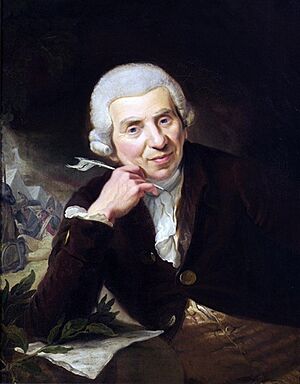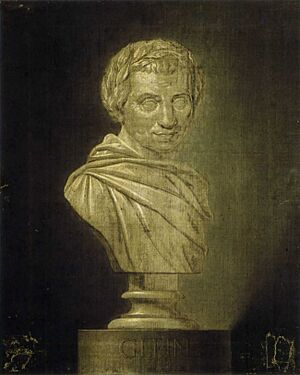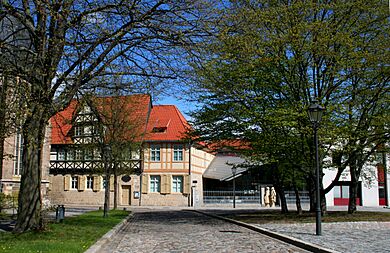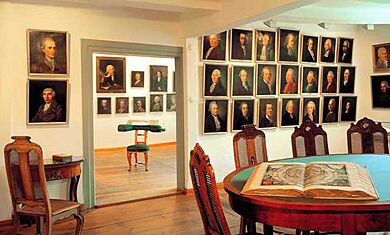Johann Wilhelm Ludwig Gleim facts for kids
Johann Wilhelm Ludwig Gleim (born April 2, 1719 – died February 18, 1803) was a famous German poet. He is known for his work during the Enlightenment and Rococo periods.
Contents
Who Was Johann Wilhelm Ludwig Gleim?
Johann Wilhelm Ludwig Gleim was born in a small town called Ermsleben in Prussia. Sadly, his parents, a tax collector and his mother, passed away when he was young. He went to school in Wernigerode. Later, in 1738, he studied law at the University of Halle. There, he became friends with other young poets like Johann Uz and Johann Nikolaus Götz. They formed a group to share their love for poetry.
After finishing his studies, Gleim worked as a tutor in Berlin. In 1743–1744, he became a secretary for Prince Frederick William of Brandenburg-Schwedt. Gleim traveled with the prince during the Second Silesian War. This is where he met Ewald Christian von Kleist, who became a very close friend.
When Prince Frederick William died during a battle, Gleim became secretary to Prince Leopold of Anhalt-Dessau. However, Gleim soon left this job. He found the prince's rough manners difficult to handle.
In 1747, after living in Berlin again, Gleim got a job as a secretary for the Halberstadt Cathedral. From 1756, he also worked as a canon at the Walbeck monastery nearby. He became known as "Father Gleim" across Germany. This was because he was very kind and supported many poets, even those who were not very good.
Gleim passed away in Halberstadt at 83 years old. He was completely blind by then. He was a wealthy and respected person in his community. He was buried in his own garden by the Holtemme river.
What Kind of Poetry Did Gleim Write?
Gleim was influenced by writers like Alexander Gottlieb Baumgarten and Georg Friedrich Meier. They taught at the University of Halle. Gleim tried to write short, easy-to-read poems, similar to the ancient Greek poet Anacreon. He wrote many poems that copied the style of Anacreon, Horace, and the minnesingers (medieval German poets).
He also wrote a teaching poem called Halladat oder das rote Buch (1774). This poem was inspired by his reading of the Quran. He also created collections of fables and romantic stories. Many of his poems were turned into songs by famous composers. These included C.P.E. Bach, Beethoven, Joseph Haydn, and Spohr.
Gleim's Famous War Songs
One of his most important works was Preussische Kriegslieder von einem Grenadier (Prussian War Songs of a Grenadier), published in 1758. These songs were inspired by King Frederick the Great's battles in the Seven Years' War. They showed real emotion and strong language. These war songs were the first of many powerful political songs in German literature.
The Kriegslieder were set to a popular tune and first put to music by Christian Gottfried Krause. They became very popular in a poetry collection edited by Lessing in 1758. Later, other composers like Telemann also set them to music.
While Gleim's other writings were popular in his time, later generations often found them a bit ordinary. However, recently, people have started to appreciate his work more. Gleim helped make German a respected language for literature. He also supported many young talented writers, such as Johann Heinrich Voss and Jean Paul.
The Gleimhaus Museum
After Gleim passed away, his great-nephew, Friedrich Wilhelm Körte, carefully looked after his belongings. In 1862, Gleim's huge library of 12,000 books was used to start a museum. This museum, called the Gleimhaus, focuses on literary life in the 18th century. It also includes a large collection of letters and documents from Gleim.
The Gleimhaus is one of the oldest literary museums in Germany. It also has collections from another local poet, Christian Friedrich Bernhard Augustin.
Gleim's Temple of Friendship
At his house near Halberstadt Cathedral, Gleim created a special place he called the Temple of Friendship (Freundschaftstempel). This was a place where poets and thinkers would meet regularly. Friends like Johann Georg Jacobi and Christoph August Tiedge often visited.
Gleim dedicated two rooms in his house to a collection of portraits of his friends. By the time he died, he had over 120 portraits! He hired famous artists like Anton Graff and members of the Tischbein family to paint these pictures.
The Gleim Prize
The Gleim Prize for Literature (Gleim-Literaturpreis) was started in 1995. It is given to people who write excellent non-fiction books about 18th-century literature.
- 1995 Heinz Dieter Kittsteiner
- 1997 Gudrun Gersmann
- 1999 Jürgen Osterhammel
- 2001 Martin Geck
- 2003 Christoph Schulte
- 2005 Angela Steidele
- 2007 Günter de Bruyn
- 2009 Mark-Georg Dehrmann
See also
 In Spanish: Johann Wilhelm Ludwig Gleim para niños
In Spanish: Johann Wilhelm Ludwig Gleim para niños





